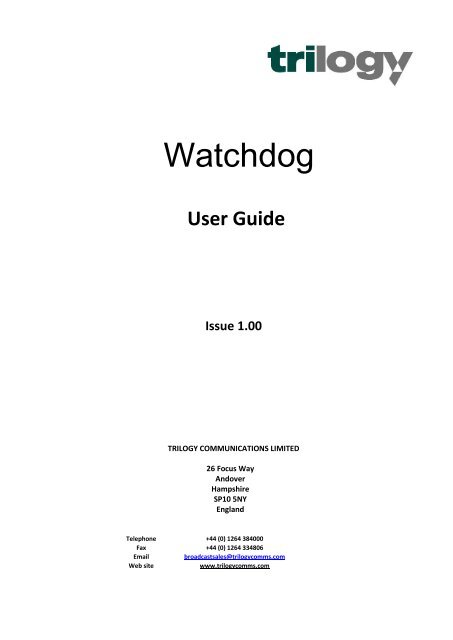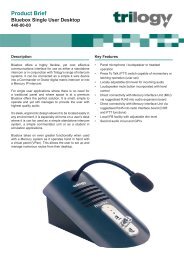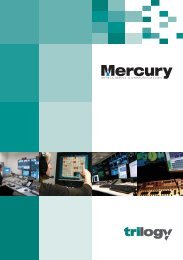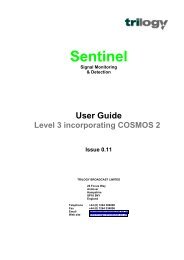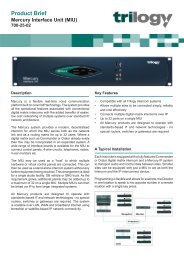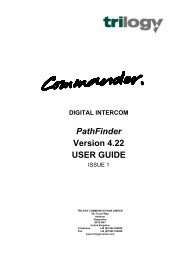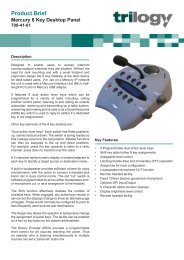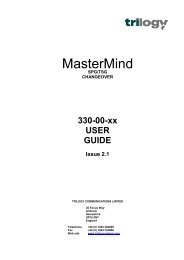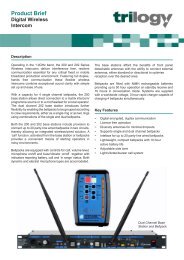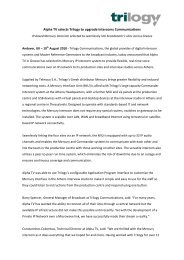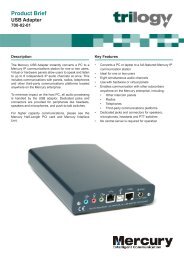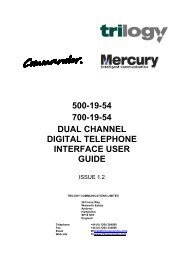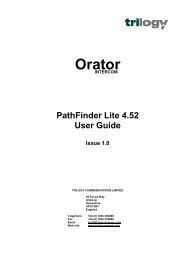Watchdog Changeover Unit User Guide - Trilogy Communications
Watchdog Changeover Unit User Guide - Trilogy Communications
Watchdog Changeover Unit User Guide - Trilogy Communications
- No tags were found...
You also want an ePaper? Increase the reach of your titles
YUMPU automatically turns print PDFs into web optimized ePapers that Google loves.
<strong>Watchdog</strong><strong>User</strong> <strong>Guide</strong>Issue 1.00TRILOGY COMMUNICATIONS LIMITED26 Focus WayAndoverHampshireSP10 5NYEnglandTelephone +44 (0) 1264 384000Fax +44 (0) 1264 334806Emailbroadcastsales@trilogycomms.comWeb sitewww.trilogycomms.com
<strong>Trilogy</strong> <strong>Communications</strong> Limited<strong>Watchdog</strong>The Copyright of the information and drawings in thisdocument is the property of <strong>Trilogy</strong> <strong>Communications</strong> Limited ofAndover, Hampshire and is neither to be reproduced in wholeor in part, nor disclosed to a third party, without the priorwritten consent of <strong>Trilogy</strong> <strong>Communications</strong> Limited.The information in this document has been carefully compiledand checked for accuracy. However, <strong>Trilogy</strong> <strong>Communications</strong>Limited accepts no responsibility for inaccuracies that mayoccur and, further, reserves the right to make changes tospecification or design without prior notice.Comments or correspondence concerning this manual shouldbe addressed to the Documentation Manager at the addressgiven at the front of this <strong>User</strong> <strong>Guide</strong>.DOCUMENT 37000610.docx Issue 1.00Issue Date Reason for Change Approved0.10 20 May 2011 First draft0.20 7 June 2011 Proof reading completed0.30 29 September 2011 Clarification of control modes0.40 21 October 2011 Text and diagram clarification0.50 8 April 2013 Corrections & 370-50-00 added1.00 14 May 2013 Added references to 370-10-02<strong>User</strong> <strong>Guide</strong> Issue 1.00 Page 2 of 28
<strong>Trilogy</strong> <strong>Communications</strong> Limited<strong>Watchdog</strong>CONTENTS1. APPLICATION .............................................................................................................................................51.1 INTRODUCTION .............................................................................................................................................51.2 AVAILABLE OPTIONS ......................................................................................................................................51.3 TECHNICAL SUPPORT......................................................................................................................................61.4 WARRANTY..................................................................................................................................................62. INSTALLATION............................................................................................................................................72.1 UNPACKING .................................................................................................................................................72.2 RACK MOUNTING..........................................................................................................................................72.3 MAINS CONNECTION AND FUSING....................................................................................................................73. 370-10-00 ACTIVE BOARD ..........................................................................................................................93.1 OVERVIEW ...................................................................................................................................................93.2 BLOCK DIAGRAM.........................................................................................................................................103.3 MONITORING .............................................................................................................................................113.3.1 Black and Burst...................................................................................................................................113.3.2 Tri-Level-Sync .....................................................................................................................................113.3.3 10 MHz Clock......................................................................................................................................123.3.4 1 PPS...................................................................................................................................................123.3.5 AES .....................................................................................................................................................123.3.6 LTC......................................................................................................................................................123.4 CHANGEOVER .............................................................................................................................................123.5 COMPARATOR ............................................................................................................................................133.5.1 1 PPS and 10 MHz Comparisons.........................................................................................................133.6 ON BOARD JUMPER SETTINGS .......................................................................................................................133.7 REAR CONNECTORS .....................................................................................................................................143.7.1 D-type – RM-03 ..................................................................................................................................143.7.2 BNC – RM-01 (without bypass relays) ................................................................................................153.7.3 BNC – RM-38 (with bypass relays) .....................................................................................................153.8 GPI ..........................................................................................................................................................163.9 BOARD EDGE CONTROLS/STATUS....................................................................................................................173.9.1 Orientation .........................................................................................................................................173.9.2 Detail..................................................................................................................................................173.10 370-10-02 ACTIVE BOARD – AES / LTC ONLY ................................................................................................184. 370-11-00 PASSIVE BOARD.......................................................................................................................194.1 OVERVIEW .................................................................................................................................................194.2 BLOCK DIAGRAM.........................................................................................................................................204.3 CHANGEOVER .............................................................................................................................................204.4 REAR CONNECTORS .....................................................................................................................................214.4.1 RM-01, RM-03, RM-38 .......................................................................................................................214.4.2 370-50-00...........................................................................................................................................214.5 GPI ..........................................................................................................................................................214.6 BOARD EDGE CONTROLS/STATUS....................................................................................................................224.7 ON BOARD JUMPER SETTINGS .......................................................................................................................22<strong>User</strong> <strong>Guide</strong> Issue 1.00 Page 3 of 28
<strong>Trilogy</strong> <strong>Communications</strong> Limited<strong>Watchdog</strong>5. SOFTWARE CONTROL/STATUS USING STATESMAN ................................................................................. 235.1 INSTALLING STATESMAN & CONFIGURING FRAMES FOR ETHERNET CONTROL ......................................................... 235.1.1 Front panel IP addresses.................................................................................................................... 235.1.2 Installing Statesman Lite ................................................................................................................... 235.1.3 Running Statesman Lite for the first time.......................................................................................... 245.1.4 Adding the frame to Statesman ........................................................................................................ 245.2 USING STATESMAN SOFTWARE...................................................................................................................... 245.3 370-10-02 ACTIVE BOARD – AES / LTC ONLY................................................................................................ 266. SPECIFICATION ........................................................................................................................................ 276.1 370-10-00 ACTIVE BOARD.......................................................................................................................... 276.2 370-11-00 PASSIVE BOARD ........................................................................................................................ 27<strong>User</strong> <strong>Guide</strong> Issue 1.00 Page 4 of 28
1. APPLICATION<strong>Trilogy</strong> <strong>Communications</strong> Limited<strong>Watchdog</strong>1.1 INTRODUCTIONThe <strong>Trilogy</strong> <strong>Watchdog</strong> cards are used within the Crystal Vision Indigo modular product system toprovide monitoring, changeover and comparison of a range of signals commonly used in a broadcastenvironment.Two cards are currently available: 370-10-00 Active Board 370-11-00 Passive BoardThe 370-10-00 has three possible control methods: Automatic, on detection of a fault condition Manual, by means of switches on the front edge of the card Software, using the Crystal Vision Statesman applicationThe 370-11-00 is controlled via GPI inputs on the rear connector. By suitable wiring, it may be set to“follow” the 370-10-00 Active Board.The 370-10-00 Active Board is designed to auto-detect most types of applied input signals. This isexplained in more detail in section 3 of this <strong>User</strong> <strong>Guide</strong>.Please contact your local supplier or <strong>Trilogy</strong> for more information.1.2 AVAILABLE OPTIONSThe following cards and rear connectors are currently available. Please contact <strong>Trilogy</strong> for an up todate listing.Part Code Description Note370-10-00 Active Board370-10-02 Active Board AES and LTC only Use only with RM-03370-11-00 Passive Board370-50-00 SDI changeover rear connector assembly Use only with 370-11-00RM-01 BNC rear connector assembly (no bypass relays) Crystal Vision part codeRM-03 D-type rear connector assembly Crystal Vision part codeRM-38 BNC rear connector assembly (with bypass relays) Crystal Vision part code<strong>User</strong> <strong>Guide</strong> Issue 1.00 Page 5 of 28
<strong>Trilogy</strong> <strong>Communications</strong> Limited<strong>Watchdog</strong>1.3 TECHNICAL SUPPORTUK & InternationalPlease contact <strong>Trilogy</strong> at the UK headquarters.<strong>Trilogy</strong> <strong>Communications</strong> Ltd26 Focus WayAndoverHampshireSP10 5NY<strong>Unit</strong>ed KingdomE-mail: broadcastsupport@trilogycomms.comTel: +44 (0)1264 384000US<strong>Trilogy</strong> USA, Inc.2500 E. Hallandale Beach Blvd, Suite 808Hallandale Beach, FL 33009-4841E-mail: support@trilogyus.comPhone and Fax: +1 847-461-1480Toll Free Phone and Fax from US: 800-372-3198In other regions please contact your local dealer. Current contact details may be found atwww.trilogycomms.com then follow links to the Broadcast division site.1.4 WARRANTYConditions of the warranty may vary according to your terms of purchase. Please consult your salesdocumentation or if in doubt, contact your original supplier or <strong>Trilogy</strong> at the offices above, quotingdate of purchase and unit serial number.<strong>User</strong> <strong>Guide</strong> Issue 1.00 Page 6 of 28
2. INSTALLATION<strong>Trilogy</strong> <strong>Communications</strong> Limited<strong>Watchdog</strong>2.1 UNPACKINGCarefully unpack the unit from its transit material and check for signs of damage. Check the contentsof the box against our despatch note and your original order to ensure that you have received thecorrect parts.In the event that the unit has been damaged or does not match your order, immediately contact yoursupplier or <strong>Trilogy</strong> at the address given at the front of this guide.2.2 RACK MOUNTINGFor rack mounting of the Crystal Vision Indigo modular frames, please refer to the Crystal Visionmanuals provided on the product CD.2.3 MAINS CONNECTION AND FUSINGFor information relating to mains connection and fusing for the Crystal Vision Indigo modular productrange, please refer to the appropriate product manuals supplied on CD.<strong>User</strong> <strong>Guide</strong> Issue 1.00 Page 7 of 28
<strong>Trilogy</strong> <strong>Communications</strong> Limited<strong>Watchdog</strong><strong>User</strong> <strong>Guide</strong> Issue 1.00 Page 8 of 28
3. 370-10-00 ACTIVE BOARD<strong>Trilogy</strong> <strong>Communications</strong> Limited<strong>Watchdog</strong>3.1 OVERVIEWThe 370-10-00 is used to provide a means of comparing and/or changing over two pairs of inputs. Theboard is able to interface with a number of different signals and will automatically detect which signalis on the inputs. The signals that the board is able to detect are:Black and burst (BB) – both PAL and NTSCTri-Level-Sync (TLS)10 MHz Clock1 PPS GPS ReferenceAES AudioLongitudinal Time Code (LTC)The type of signals the board is able to detect depends on the rear module fitted to the frame.BB, TLS, 10 MHz and 1 PPS can be detected when the BNC rear module is fitted.Balanced AES and LTC can be detected when the rear module with D-Type connectors is fitted.The board can operate in one of five control modes:Automatic, where a signal fault causes changeover to the other signalGUI, using the optional Statesman softwareManual, using controls on the front edge of the boardRemote, using GPIs from other cards in the system. Remote control is only available whenactivated via the Statesman GUISNMPThere is no prioritisation of the selection of a control mode.For example, if Statesman is used to set the mode to “Auto” and then the front edge switches areused to set an output to A, the output will change to A and stay on A even if there is a signal fail oninput A. The converse is also true; if the card edge switches are set to “A” and then Statesman is usedto set the mode to “Auto”, then the board will adopt the automatic mode. Although this will not leadto a conflict, it could cause confusion because the front edge switches will not necessarily indicate thetrue operating mode of the board. For this reason we advise using either the front edge switches, orStatesman to set the control mode, but not both.The 370-10-00 has a number of different applications depending on the input type.Monitoring: For all input types the signals are continuously monitored. If a fault is detected itis reported via the Statesman software.<strong>Changeover</strong>: On detection of a fault on input A, the fault is reported and depending on howthe board is set up, the changeover occurs, either automatically or manually.Comparator: For BB, TLS, 10 MHZ and 1 PPS the 370-10 Active Board will compare the 2 inputsand calculate the difference in phase between the 2 inputs. Also when Channel 1 inputs are 10MHz and channel 2 inputs are 1 PPS, comparisons between the inputs will be made.<strong>User</strong> <strong>Guide</strong> Issue 1.00 Page 9 of 28
<strong>Trilogy</strong> <strong>Communications</strong> Limited<strong>Watchdog</strong>3.2 BLOCK DIAGRAM<strong>User</strong> <strong>Guide</strong> Issue 1.00 Page 10 of 28
<strong>Trilogy</strong> <strong>Communications</strong> Limited<strong>Watchdog</strong>3.3 MONITORINGThe fail conditions for each input signal type are described in the following sections. When a failcondition is detected it is reported via the Statesman GUI and indicated by Status LEDs on the edge ofthe board.3.3.1 Black and BurstThe 370-10-00 is able to detect both PAL and NTSC black and burst signals.The following conditions will cause a fail indication:Input level error:o If the sync level of the applied input signal is 500 mV. It will indicate a failure for unterminatedsignals.If the line frequency is not within 4% of the line frequency based on an internal oscillator.The presence of the burst is detected. When the burst amplitude is less than 10% of the peakto peak specification, a “fail” condition is indicated.3.3.2 Tri-Level-SyncThe 370-10-00 can detect the following TLS standards:1920x1080/60/p1920x1080/59.94/p1920x1080/50/p1920x1080/60/i1920x1080/59.94/i1920x1080/50/i1920x1080/30/p1920x1080/29.97/p1920x1080/25/p1920x1080/24/p1920x1080/23.98/p1920x1080/30/sF1920x1080/29.97/sF1920x1080/25/sF1920x1080/24/sF1920x1080/23.98/sF1280x720/60/p1280x720/59.94/p1280x720/50/p1280x720/30/p1280x720/29.97/p1280x720/25/p1280x720/24/p1280x720/23.98/pThe standard detected is reported via the Statesman GUI.The following conditions will cause a fail indication:Input level error:o If the sync level of the applied input signal is 500 mV. It will indicate a failure for unterminatedsignals.The line frequency is not within 4% of the line frequency based on an internal oscillator.The frame frequency is not within 0.5% of the standard detected. For some standards it ispossible the wrong standard will be detected if outside of this specification.<strong>User</strong> <strong>Guide</strong> Issue 1.00 Page 11 of 28
<strong>Trilogy</strong> <strong>Communications</strong> Limited<strong>Watchdog</strong>3.3.3 10 MHz ClockThe following condition will cause a fail indication: The amplitude of the applied input signal is
<strong>Trilogy</strong> <strong>Communications</strong> Limited<strong>Watchdog</strong>3.5 COMPARATORFor all unbalanced inputs the timing difference between inputs A and B is calculated to an accuracy of±10 ns. The GUI is able display a timing difference of ±999 999 990 ns.When channel 1 inputs are 1 PPS and channel 2 inputs are 10 MHz, a comparison is made between 1PPS on input A of channel 1 and the 10 MHz clock on input A of channel 2. The same comparisons willbe made on input B of both channels.3.5.1 1 PPS and 10 MHz ComparisonsFor each channel, the number of 10 MHz clock cycles in the 1 PPS is counted. The countshould be 10,000,000. If the number of clock cycles deviates from this, the difference isreported via the Statesman GUI.The 10 MHz inputs are compared over one second and a fail condition is indicated if theydeviate by more than 0.1ppm. The difference is reported via the Statesman GUI.The 1 PPS signals are compared. A fail condition is indicated if there is a difference of± 200 ns between the two “one-second” pulses. The difference is reported via the StatesmanGUI with an accuracy of ± 20 ns.3.6 ON BOARD JUMPER SETTINGSJumpers J7, 8, 9 and 11 are for factory use only and should be set to the “in” position.Jumper set J1 selects the balanced signal type for Channel 1 when using D-type rearconnectors. Set “in” for LTC inputs: “out” for AES inputs. Jumper set J2 performs the same function for Channel 2.<strong>User</strong> <strong>Guide</strong> Issue 1.00 Page 13 of 28
<strong>Trilogy</strong> <strong>Communications</strong> Limited<strong>Watchdog</strong>3.7 REAR CONNECTORS3.7.1 D-type – RM-0315 Way D-Type chassis femalePin Signal1 AES Ch1 In B-2 AES Ch1 In A+3 AES Ch1 In A-4 Gnd5 Gnd6 AES Ch2 In A+7 AES Ch2 In B+8 BNC Ch1 In B §9 AES Ch1 In B+10 BNC Ch1 Out §11 BNC Ch1 In A §12 Gnd13 Gnd14 AES Ch2 In A-15 AES Ch2 In B-25 Way D-Type chassis femalePin Signal1 GPI a (Channel 1 out) §§2 GPI c (Channel 1 in) §§3 GPI e (currently unused) §§4 Gnd5678910 AES Out Ch2+11 Gnd12 AES Out Ch1+13 Gnd14 GPI b (Channel 2 out) §§15 GPI d (Channel 2 in) §§16 GPI f (currently unused) §§17 Gnd1819 BNC Ch2 In B §202122 BNC Ch2 Out §23 AES Out Ch2-24 AES Out Ch1-25 Gnd§ -- these pins should be left floating; only active when BNC rear connector is fitted.§§ -- GPI lines are also provided on frame connector, adjacent to PSU. See Crystal Vision Indigo framemanual for more information.<strong>User</strong> <strong>Guide</strong> Issue 1.00 Page 14 of 28
<strong>Trilogy</strong> <strong>Communications</strong> Limited<strong>Watchdog</strong>3.7.2 BNC – RM-01 (without bypass relays)Ch1 A Ch1 B Ch2 B Ch2 out Ch2 A Ch1 outNote:1. The input sequence for channels 1 & 2 is correct as shown above.3.7.3 BNC – RM-38 (with bypass relays)Ch1 A Ch1 out Ch1 B Ch2 B Ch2 out Ch2 ANote:1. The input sequence for channels 1 & 2 is correct as shown above.<strong>User</strong> <strong>Guide</strong> Issue 1.00 Page 15 of 28
3.8 GPI<strong>Trilogy</strong> <strong>Communications</strong> Limited<strong>Watchdog</strong>The GPIs are used to interface with the other active and passive boards in the frame. GPI outputsindicate when a changeover has occurred: GPI inputs accept a command from other boards to cause achangeover. GPI input remote control is only active when turned on via the Statesman GUI. Boardswhich are responding to remote control via their GPI inputs must also be set to Automatic mode. For asystem with multiple cards where simultaneous switching is required, GPIs must be wired in a chain,linking out to in successively, forming a complete circle.GPI a (Channel 1) and GPI b (Channel 2) are configured as GPI outputs. They indicate the current stateof each channel: when inactive (open circuit) then input A is routed to the output when active (short circuit) then input B is routed to the outputGPI c (Channel 1) and GPI d (Channel 2) are configured as GPI inputs. They are used to remotelycontrol the changeover action of each channel: when the input is floating, signal input A is routed to the output when the GPI input is grounded, signal input B is routed to the output.All GPI inputs and outputs, from each slot in the frame are also available on a D type connectoradjacent to the power supply. When using the BNC rear connector, all GPI wiring should use thisconnector. Please see the Crystal Vision Indigo frame manual for more information.GPI e and f are currently unused.<strong>User</strong> <strong>Guide</strong> Issue 1.00 Page 16 of 28
<strong>Trilogy</strong> <strong>Communications</strong> Limited<strong>Watchdog</strong>3.9 BOARD EDGE CONTROLS/STATUSThe edge of the board has switches to control the function of the board and status LEDs. The diagrambelow shows the layout for the board edge. The LEDs/Switches on the left are for channel 1 and thoseon the right for channel 2. The LEDs on the bottom indicate the status for input A; those on the topindicate the status for input B.3.9.1 Orientation3.9.2 DetailSignal Present/Valid<strong>User</strong> <strong>Guide</strong> Issue 1.00 Page 17 of 28
<strong>Trilogy</strong> <strong>Communications</strong> Limited<strong>Watchdog</strong>This LED has three states:Signal Present LED ↓ Signal Type LEDs IndicatesOff Off No signal detectedOnSignal errors detected: signal type as shownFlashing On Valid signal but not expected type or subtype(BB and TLS only)On On Valid signal: signal type as shownSignal type – 3 LEDs are used to code the type of signal as binary coded decimal. The input types areshown in the table below.BCD Input Type“000” No Signal“001” Black and burst“010” Tri-Level Sync“011” 1 PPS“100” 10 MHz Clock“101” LTC“110” AES“111” Reserved for future useControl Switches – Each channel has 6 DIP switches. The switches are defined as:SWITCH Function1 Change over is automatic when down, manualwhen up.2 Selects which input is routed to the outputwhen in manual mode. Input A when down,input B when up.3 When down input type is detectedautomatically, when up input type is set usingswitches 4 to 6.4 to 6 Input type, up- ‘1’, down – ‘0’BCD signal type code follows the LED table(above).Power – LED is illuminated when board has power.3.10 370-10-02 ACTIVE BOARD – AES / LTC ONLYThe 370-10-02 is a reduced feature version of the 370-10-00. It can only be used to detect andchangeover AES and LTC signals. It should only be used in conjunction with the D-type rear connector,part number RM-03. The board can be managed using the Statesman software and an image is shownin section 5.3.<strong>User</strong> <strong>Guide</strong> Issue 1.00 Page 18 of 28
4. 370-11-00 PASSIVE BOARD<strong>Trilogy</strong> <strong>Communications</strong> Limited<strong>Watchdog</strong>4.1 OVERVIEWThe 370-11-00 is used to provide a means of changing over two pairs of inputs. There are no on-boarddetection or comparator circuits and the primary purpose of the board is to changeover additionalcircuits under control of an accompanying 370-10-00 Active Board. The 370-11-00 is not recognisedand cannot be controlled by the Statesman GUI software.The board is able to interface with a number of different signal types:Black and burst (BB) – both PAL and NTSCTri-Level-Sync (TLS)Analogue Video10 MHz Clock1 PPS GPS ReferenceAES AudioLongitudinal Time Code (LTC)SD / HD / 3G SDI (using the 370-50-00 rear connector assembly)Note: only 370-11-00 boards marked as “Mod State 3” aresuitable for switching SDI signals, in conjunction with the 370-50-00 rear connector assembly. See section 4.5 on page 21 forinformation concerning the GPI connections.The type of signals the board is able to switch depends on the rear module fitted to the frame.BB, TLS, 10 MHz, Analogue & Digital video and 1 PPS can be switched when the BNC rearmodule is fitted.Balanced AES and LTC can be switched when the rear module with D-Type connectors is fitted.SD / HD / 3G SDI when the 370-50-00 rear connector assembly is fittedThe board can operate in one of two control modes:Manual, using controls on the front edge of the boardRemote, using GPIs from other cards in the system.The 370-11-00 is used in changeover applications:Channel 1 and / or channel 2 will switch from A to B input, depending on either the front edgecontrols or external GPI inputs.<strong>User</strong> <strong>Guide</strong> Issue 1.00 Page 19 of 28
<strong>Trilogy</strong> <strong>Communications</strong> Limited<strong>Watchdog</strong>4.2 BLOCK DIAGRAM4.3 CHANGEOVERFor each changeover set it is possible to route either of the two inputs to the output; this can be donemanually or by GPI input control. Channels 1 and 2 can switch independently or in tandem: when setto operate in tandem using the front edge switches, the Channel 1 controls act on both channels.The 370-11-00 uses relays to switch between inputs A and B. The changeover takes no longer than6ms.The BNC rear module has bypass relays which route input A to the output when the board is notpresent.Controls on the front of the board set whether changeover occurs using the GPI inputs or manually.Manual changeover - The user is able to manually change over using the board edge switches.GPI (remote) changeover – GPI ‘c’ is used to changeover channel 1, GPI ‘d’ is used to changeoverchannel 2. When the GPI input is left floating, input A is routed to the output, when it is grounded,input B is routed to the output.<strong>User</strong> <strong>Guide</strong> Issue 1.00 Page 20 of 28
<strong>Trilogy</strong> <strong>Communications</strong> Limited<strong>Watchdog</strong>4.4 REAR CONNECTORS4.4.1 RM-01, RM-03, RM-38The 370-11-00 can use the same BNC and D-type rear connectors as the same 370-10-00 Active Board;see section 3.7 on page 14.4.4.2 370-50-00The 370-50-00 rear connector assembly is used to change over SDI signals in SD, HD or 3G format.Ch1 A Ch1 out Ch1 B Ch2 B Ch2 out Ch2 ANote:The input sequence for channels 1 & 2 is correct as shown above.The 370-50-00 may only be used with “mod state 3” 370-11-00 modules. See sections 4.1 and4.5.4.5 GPIThe GPIs are used to interface with the other active and passive boards in the frame. GPI inputs accepta command from other boards to cause a changeover. Remote control is only active when selectedusing the front edge controls (see section 4.6 below).GPI c (Channel 1) and GPI d (Channel 2) are configured as GPI inputs. They are used to remotelycontrol the changeover action of each channel. When the input is floating, signal input A is routed to the output When the GPI input is grounded, signal input B is routed to the output.All GPI inputs from each slot in the frame are also available on a D type connector adjacent to thepower supply. When using the BNC rear connector, all GPI wiring should use this connector. Pleasesee the Crystal Vision Indigo frame manual for more information.GPI e is used with modification state 3 boards only and should be pulled down to ground when the370-50-00 rear connector assembly is fitted. For all other rear connector assemblies, GPI e should beleft floating.GPI a, b, and f are currently unused.<strong>User</strong> <strong>Guide</strong> Issue 1.00 Page 21 of 28
<strong>Trilogy</strong> <strong>Communications</strong> Limited<strong>Watchdog</strong>4.6 BOARD EDGE CONTROLS/STATUSThe edge of the board has switches to control the function of the board and status LEDs. The diagrambelow shows the layout for the board edge. The LEDs/Switches on the left are for channel 1 and thoseon the right for channel 2. The LEDs on the bottom indicate the status for input A; those on the topindicate the status for input B.Independent Control – When up, the 2 channels work independently of each other; when down, bothchannels are controlled in tandem by channel 1 controls.GPI/Manual –When down, change over is controlled manually using the switches on the front of theboard. When up, change over is controlled via the GPI inputs.A or B – When board is in manual change over mode Input A is routed to the output when down.Input B is routed to the output when up.LED A – Illuminated when input A is routed to the outputLED B – illuminated when input B is routed to the outputPower – LED is illuminated when board has power.4.7 ON BOARD JUMPER SETTINGSJumpers J3 and J4 are for factory use only and should be fitted such that pins 1 & 2 are connected.<strong>User</strong> <strong>Guide</strong> Issue 1.00 Page 22 of 28
<strong>Trilogy</strong> <strong>Communications</strong> Limited5. SOFTWARE CONTROL/STATUS USING STATESMAN<strong>Watchdog</strong>5.1 INSTALLING STATESMAN & CONFIGURING FRAMES FOR ETHERNET CONTROLA straight through (non crossover) CAT5 cable should be connected from the PC to a network switchand from the network switch into the Ethernet connector on the rear of the frame.Connections direct from the PC to a frame using a cross over cable are currently not supported.5.1.1 Front panel IP addressesWhen a frame leaves the factory, by default the front panel will be set to DHCP. If you are running aDHCP network the front panel will set a relevant available IP address with the same subnet mask asyour network.If you need to set your own IP address please follow these steps:1. Power the front panel with piano switch 4 on the front panel PCB in the down position (youwill see this on the rear of the front panel when it is open). This will set an IP address of10.0.0.201 and subnet mask of 255.255.255.02. Set your PC to the same IP address range and subnet mask e.g. 10.0.0.200 & 255.255.255.0.Note how the last number in the PC IP address has to be different in order to uniquely identifyit. To change the IP address of a PC go to Start > Settings > Network Connections. Right mouse click on the active connection and select “Properties” in the pop-up menu. Highlight Internet Protocol (TCP/IP) and click properties. Select “use the following IP address” and type in the address and Subnet mask. The defaultgateway can be left as it is.3. Ping the frame from DOS. To run a DOS prompt in Windows XP go to Start > Run and then type “cmd” (without thespeech marks). To ping the frame type ping followed by the IP address of the frame, leaving a spacebetween ping and the IP address e.g. C:\>ping 10.0.0.2014. With communication between the PC and frame established open a web browser and type inthe IP address of the frame (http://10.0.0.201). This will display a page for the Ethernet CPUyou are talking to.5. Click on the select network tab and type in the new IP address and subnet mask you wouldlike to set the frame to. Make sure DHCP is not ticked before confirming selection.6. Put piano switch 4 back to the up position and re-boot the front panel for the new settings toload.7. Change your PC back so it is in the same IP address and subnet mask range as set on theframe.5.1.2 Installing Statesman Lite1. Run the cvsetup.exe file for the version of Statesman you are installing.2. Click “Next” until you reach the Select Components screen. Un-check Statesman LicenseServer and MySQL user setup. These are only required for multi PC installations.3. Continue clicking “Next” then finally click Install.<strong>User</strong> <strong>Guide</strong> Issue 1.00 Page 23 of 28
<strong>Trilogy</strong> <strong>Communications</strong> Limited<strong>Watchdog</strong>5.1.3 Running Statesman Lite for the first time1. Launch Statesman.2. As this is a new installation there is no database backup to reinstall. “Use defaults” thereforeneeds to be selected on the “Reinstall database from backup?” pop-up.3. Now you need to enter and confirm the password you would like to use to log in toStatesman.4. Now login by leaving the user as Supervisor and entering the password you selected. Here youcan choose to store password at login to avoid having to enter it each time you runStatesman.5. In the Statesman setup pop up click Next on Introduction, Network on Network type and waitwhile Statesman probes the Network for accessible frames. Then click single PC on servers. Atthis stage do not add the rack that is visible in the Add a Rack tab. We will do this later withinStatesman.6. An update file is provided on the CD. To install the update:i. Click “Data->Update Control Panel Data” and then select the “Use local file” optionii. Navigate to the product data file provided in the “software” folder of the CD.iii. Click OKiv. Waitv. Restart Statesman5.1.4 Adding the frame to Statesman1. With communication established between the PC and frame, launch Statesman.2. Click on ‘Statesman Settings’ then ‘Options’3. Click on the tab called ‘Racks’ followed by ‘Racks defined’ and then ‘Add Rack’. The IPaddresses of the frames you want to add to Statesman should be visible.4. Highlight the IP address of a frame for your area and click ‘OK’.5. Click ‘OK’ again on the options box and then the frame will appear on the left hand panel ofStatesman.5.2 USING STATESMAN SOFTWAREThe 370-10-00 Active Board can be controlled via the optional Statesman GUI software. The imagebelow shows a screenshot from the software.<strong>User</strong> <strong>Guide</strong> Issue 1.00 Page 24 of 28
<strong>Trilogy</strong> <strong>Communications</strong> Limited<strong>Watchdog</strong>Channel Pair – This box contains the controls and status of the inputs of each channel pair.Signal to detect - The type of signal to detect can be selected by selecting the appropriatesignal type, alternatively it can be set to auto. In this mode the input type for both inputs isdetected automatically. If the inputs are of different types or subtypes input A is assumed tobe the correct type.Timing Difference – When inputs A and B are the same type and subtype the timingdifference between the 2 inputs is calculated to an accuracy of +/- 10ns.Select – This sets how the changeover is controlled:oooRemote – When the box is ticked, the changeover is controlled via the GPI inputs.Note: GPI outputs are active at all times.Auto – When selected, if an error is detected on the input routed to the output, achangeover will take place if there are no errors on the other input.A and B – Manually select which input is routed to the output.Note: when controlling multiple boards, the “Remote” checkbox must be ticked and the“Auto” radio button selected on all boards.<strong>Changeover</strong> LED – Red when changeover has occurred. Press “Reset LED” to reset.Output LEDs – Indicates which input is routed to the output.Input x – This box indicates which signal type has been detected on the inputs and the signal quality.Signal Detected – These LEDs indicate if a signal is present and the signal type detected. If BBor TLS are detected the subtype of the signal will be displayed e.g. for BB - PAL or NTSC.Signal Quality – The LEDs indicate if an error has been detected on the input signal. The Errorschecked for are displayed depending on the signal type detected e.g. For BB, input level, linefrequency, frame frequency, burst present and burst amplitude are checked. For AES the inputlevel is checked. If there is an error the LED turns red.<strong>User</strong> <strong>Guide</strong> Issue 1.00 Page 25 of 28
Between Pairs –<strong>Trilogy</strong> <strong>Communications</strong> Limited<strong>Watchdog</strong> Inputs x 10 MHz/1 PPS Comparison – When this box is ticked and there are valid 1 PPS and 10MHz signals on the inputs the number of 10 MHz clock pulses in the 1 second period arecounted. The cycle count error reports number of 10 MHz clock pulses above or below 10million in the 1 second pulse period. Error range is +/- 127: if the error is greater than this 127will still be reported.Independent Change Over – When the box is checked, the changeover of the channel pairsare independent of each other. When it is unchecked, an error on either of the inputs routedto the output will cause a changeover for both channel pairs if the other inputs are valid withno errors. The board can only be switched into (or out of) this mode using the GUI and thecurrent setting is not indicated on any card LEDs.By default the card will start up in automatic mode. In this mode the input type will be automaticallydetected and the changeover will occur automatically.5.3 370-10-02 ACTIVE BOARD – AES / LTC ONLYThe image below shows the reduced features provided by the 370-10-02, as seen from Statesman.<strong>User</strong> <strong>Guide</strong> Issue 1.00 Page 26 of 28
6. SPECIFICATION<strong>Trilogy</strong> <strong>Communications</strong> Limited<strong>Watchdog</strong>Note. All measurements are made assuming, where appropriate, that the various offsets controlledfrom the front panel are set to zero unless otherwise stated. All signal measurements are made withinputs and outputs terminated in 75Ω unless otherwise stated.6.1 370-10-00 ACTIVE BOARDReturn LossIsolation between A and B channelsInsertion Loss< -35dB to 10 MHz< -30dB @ 30 MHz> -60dB to 10 MHz< 1dB6.2 370-11-00 PASSIVE BOARDReturn LossIsolation between A and B channels< -35dB to 10 MHz< -30dB @ 30 MHz> -60dB to 10 MHz<strong>User</strong> <strong>Guide</strong> Issue 1.00 Page 27 of 28
<strong>Trilogy</strong> <strong>Communications</strong> Limited<strong>Watchdog</strong><strong>User</strong> <strong>Guide</strong> Issue 1.00 Page 28 of 28


